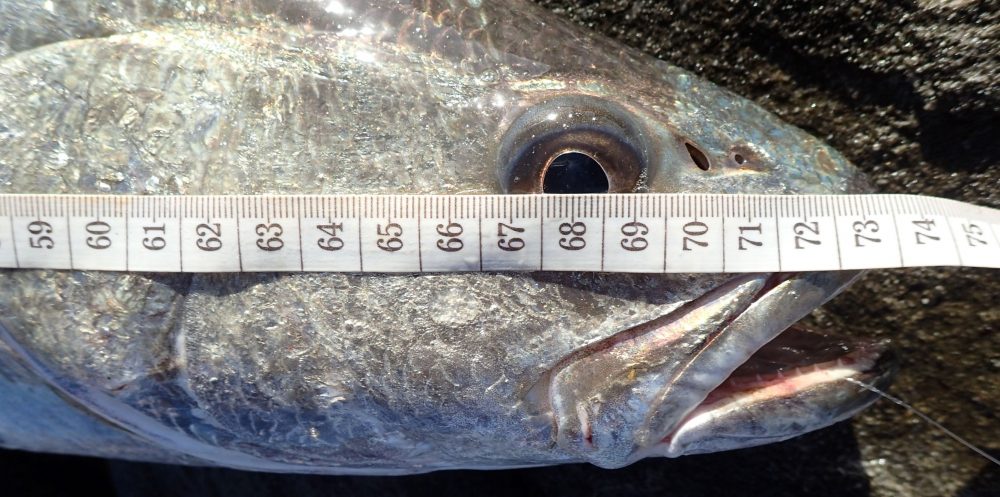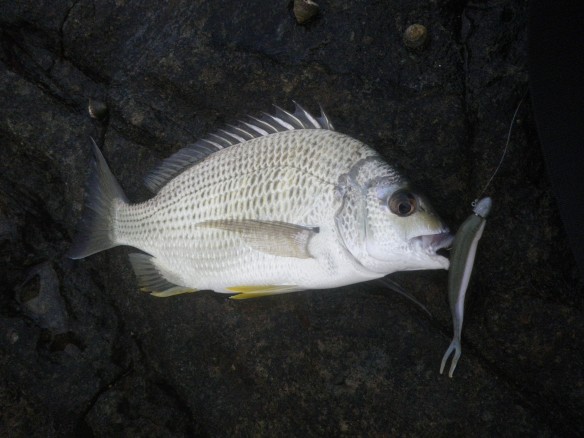
TAILOR CAUGHT ON SOFT PLASTICS

ILUKA TAILOR

TWEED TAILOR
I am sure you have all heard it said a million times – if you want to catch some Tailor you can’t go past a lightly weighted, West Australian Pilchard floating down off the back of the boat or a well place chrome slug cast from the rocks. Don’t get me wrong – it’s sound advice and it definitely will get you some fish, but I thought I would offer my experience of catching Tailor on soft plastic lures.
As you may have worked out, I love to fish with soft plastics and I almost only fish from the shore. So my experience of catching Tailor is based on those parameters. Firstly, most of the time when I get a good (keeper size – 35cm + QLD or 30cm + NSW) ‘chopper’, it is an accident. I am usually not targeting them; they just wallop whatever I am fishing with. I am usually prospecting on some sand flats, beside a bridge or rock wall and suddenly the line starts peeling and the rod starts shaking and I realise that I either have a Flathead on steroids or it’s a Tailor. This usually results in a bite off as I fish pretty light (10 to 12lb leader), but occasionally, if the fish is nicely hooked, I will get it safely to the bank. The plastic is usually pretty smashed up but if I cast it straight back out, I often get another. Then they are gone.
So this year, as the weather cooled, I decided I would actually try to catch some tailor with plastics. The first thing I did was switch to heavier tackle. I decided on a 6000 size spinning reel, loaded with 12lb Fireline down to a 20lb fluorocarbon leader. I also made sure I had the toughest jigheads that I could find, from 1/6th to ½ ounce. Then I thought about my rod. The problem, when choosing a rod for plastics in these circumstances, is the immediate compromise between strength and sensitivity. A ‘medium’ weight estuary spinning rod (something like a 7’6 3-6kg Berkeley Dropshot) gives you a good, sensitive connection to the soft plastic and so you can fish fairly light weight jigheads (1/8 to ¼ ounce) and still cast them out effectively. However if you hook up to a decent fish (in my book that is anything over 2kg) you are really going to struggle, especially if you need to pull it up a rock wall or onto a ledge. The alternative is to go heavier but then, inevitably, you lose a bit of the sensitivity. My ‘heavy’ plastics rod is the 11 Ft 6-15kg Rovex BARIO. This rod still has some feel in the tip but it is strong enough to heave some decent fish up the rocks. The downside is that it is very difficult to fish with much less than a 3/8 ounce jighead, as the rod is really too stiff to feel anything lighter. I have landed plenty of 2 to 5 kg fish with this rod – if you hook up with anything much heavier then you really need a mate with long handled gaff.
Once I had decided on the set up I looked for likely locations. This was tricky as I have caught Tailor from Yamba in Northern NSW right up to 1770 in Queensland, but I have usually caught the bigger ones when chasing jewfish from the rocks.
So my first experimental Tailor plastics session was fishing the end of the rock wall at the mouth of the Tweed River, about a month ago (in mid June). I find that the north side of the north rock wall is a good fishing spot, so I arrived an hour before dawn and found a large flat boulder near the end of the wall. I rigged up the ‘heavy’ rod. So which plastic to choose? Working on the principle that Tailor love Pilchards – I chose the GULP 4” Minnow in Pearl Watermelon – as it looks quite like one. It is basically a dark green on top with silver coloured under body and v shaped tail. It is an excellent all rounder that I often start with it. I rigged it on a 3/8 2/0 jighead. The first few casts – in the dark – produced nothing. Fishing from the rocks in the dark is pretty hit and miss, not to mention dangerous, so I usually wait for the pre-dawn light to see what I am doing. Yes – I have a headlamp but it is pretty easy to spook the fish by shining a few high powered LEDs down at them. Sure enough just as the horizon started to glow I got a couple of solid hits and then a good fish took the plastic right at the foot of the wall, on a fairly quick retrieve. A bit too big for a Bream and a bit too frenetic for a trevally, sure enough it was a good ‘chopper’, probably around 40cm. Once I turned it around, it broke the surface, in the foam, by the rocks, but as soon as I lifted it clear of the water, it started wriggling and wriggled off the jighead. In the space of half an hour, I had four more fish of a similair size. I landed two and lost two in a similair manner to the first. They have very soft mouths and once they are out of the water it is very difficult to stop yourself pulling the hook out. Then all went quiet for about forty minutes and they were back again. They were obviously chasing the bait schools up and down the rock wall. This time round (using the same plastic) I dropped the first fish and was bitten off by the second. By the time I had re-rigged they were gone. I stayed the rest of the morning and caught a few bream but the Tailor did not come back. The plastics had certainly taken a beating – I had to put a new one on after every successful hook up – but it seemed like a reasonable trade off.
The next trip was down to Iluka Bluff in Northern New South Wales. I had a couple of days there but due to the weather I could only manage two fishing sessions – the morning and evening of the first day. Conditions on that morning were perfect with only a light swell and virtually no wind. The Bluff is a large flat ledge at the end of a headland and there are tailor here all year round although they improve in size and numbers in the cooler months. Again I arrived in position pre-dawn on the southern side of the Bluff. I started with the same rig except I ran a 40lb leader and switched to the same shaped plastic in the Pumpkinseed colour. About 30 mins after dawn I was bitten off, then after re-rigging, I landed a nice 50cm Tailor and dropped two more in quick succession. Things slowed for an hour or so and then I down sized to a twenty pound leader. Third cast with the lighter leader and I was onto a decent fish which rubbed me off, but after a quick re-rig I got another 45cm fish which I landed. Downsizing the leader as the sun gets higher in the sky often works for me in this way, as does matching the size of the plastic, as closely as possible, to the bait that’s already in the water.
That evening the wind was up and so was the swell. Again the fish appeared to come on and off every 20 to 30 minutes. It certainly seemed like they were cruising up and down in front of the headland, chasing the bait. Each time they came by I would get a couple of knocks and nudges and sometimes a hook up. I like to use a pretty standard retrieve – it is always a tricky balance between getting the fairly heavy jigheads (3/8 ounce) down low in the water column and not getting snagged on the bottom. I usually cast out and count slowly to ten. On ten, I jerk the rod tip up, and pause while the plastic sinks again. Then I wind in some line and repeat the process. Finally, just on dusk I got the best fish of the trip – a 65cm Tailor and fortunately the rising swell more or less landed it for me, by washing it up over a ledge right at my feet. This time I had switched to the 5” Jerkshad plastic also in the pumpkinseed colour.
Although two trips hardly make a definitive study, I have had many rock fishing sessions which have produced Tailor on soft plastic lures and I think I can draw the following key conclusions.
There are a few disadvantages to using plastics. Firstly, they are expensive – the Tailor destroy them and you will rarely get two fish out of one plastic, often they will get munched before you even get a fish to the shore. Secondly, you certainly cannot cast them as far as a heavily weighted bait or slug. Thirdly, jigheads often do not hook up as solidly as a treble right in the mouth – so slugs can make it easy to lift the fish to safety without pulling the hook.
However, the single biggest advantage of using soft plastics for Tailor is the ability to fish a moving lure through the lower part of the water column, more consistently, than you could a bait or a slug. You simply cannot move bait along the bottom with the action of a plastic and a slug is almost always on an upward trajectory once it gets up to speed. So if the fish are travelling along, or close to the bottom, I think you will get more hooks ups with a soft plastic, than with a slug or bait. Of course, if they are feeding on the surface they will still take the plastic on the drop, but maybe they will be more interested in a surface popper, fast moving slug or lightly weighted pilchard.
Of course, none of the above applies in the weeks that lead up to spawning off Fraser Island. If you can locate the fish at that time – they are usually so thick and so competitive that you can catch them with almost any type of bait, lure or even an old sock!
I hope you found this useful and, as always I would welcome any comments – questions or experiences that you may wish to share.












